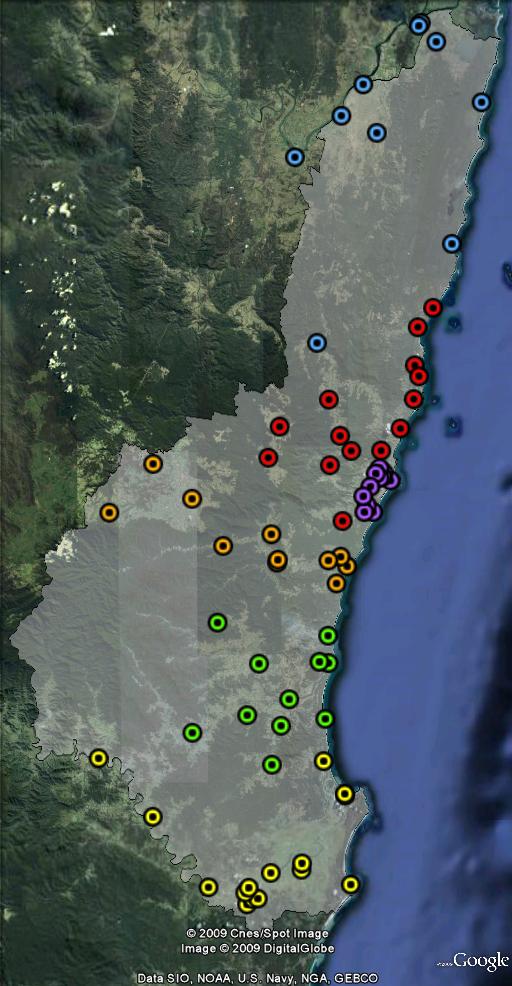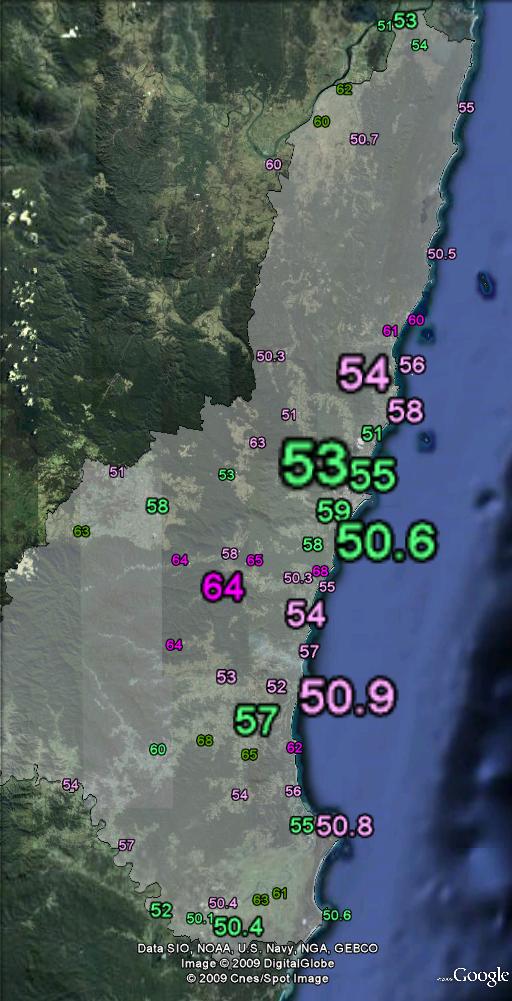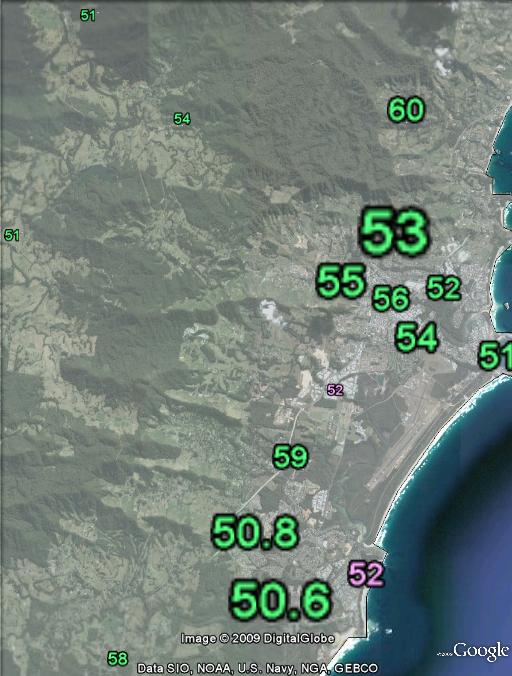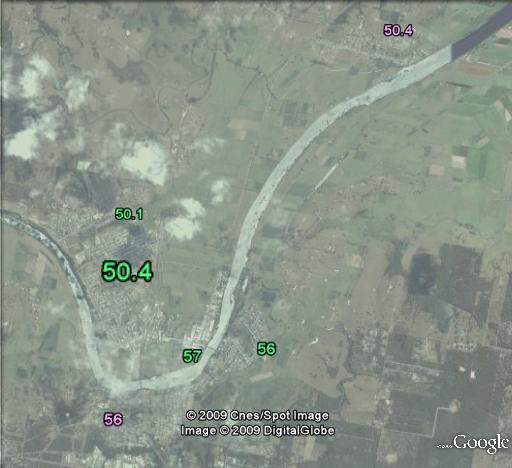NAT 1.2%
Incumbent MP
Luke Hartsuyker, since 2001.
Geography
Cowper lies on the mid-north coast of New South Wales, stretching from Kempsey to Maclean. The seat covers the towns of South West Rocks, Nambucca Heads, Bellingen, Coffs Harbour and areas near Maclean and Grafton.
Redistribution
Cowper’s boundaries have remained almost entirely the same. A small areas south of Grafton was transferred to the neighbouring seat of Page.
History
Cowper was an original federation seat, and has almost always been held by conservative parties, with the Country/National Party holding it for all but two years since 1919.
The seat was first held by Francis Clarke of the Protectionist Party, who was defeated by Free Trader Henry Lee in 1903. Lee was defeated by John Thomson in 1906. Thomson first held the seat for the Protectionist Party and held the seat for successive non-Labor parties for the next 13 years.
In 1919, Thomson, then representing the Nationalists, was defeated by Earle Page, who joined the Country Party the next year. Page held the seat for over 40 years.
Page became Country Party leader in 1921 and led the party into government for the first time in 1922, forcing the senior Nationalists to drop Billy Hughes as Prime Minister. He served as Treasurer in the Bruce government until 1929. He also served as a minister in the second and third terms of the Lyons government, and served as acting Prime Minister for three weeks upon Lyons’ death.
Page refused to serve in a government led by Lyons’ deputy Robert Menzies, but the Country Party rebelled and replaced Page with a new leader. Page returned to government in 1940 as a minister, and again served as a minister from 1949 to 1956. Page continued to serve in Parliament until the 1961 election. At that election, he was too ill to campaign and fell into a coma before the election. In a surprise upset, Page was defeat by the ALP’s Frank McGuren, and he died days later.
McGuren only held the seat for one term, which was the only term the ALP has ever held Cowper. He was defeated in 1963 by the Country Party’s Ian Robinson. Robinson transferred to the new seat of Page in 1984, and Garry Nehl won Cowper for the Nationals. Nehl retired in 2001, and was succeeded by Luke Hartsuyker. At the 2007 election, Hartsuyker’s margin was cut to 1.2%, making it a marginal electorate. This took place despite the ALP changing candidates late in the piece, when John Fitzroy was replaced by Paul Sefky, over the protests of local branches.
Candidates
- Paul Sekfy (Labor)
- Dominic King (Greens)
- John Arkan (Independent)
- Deborah Lions (Christian Democratic Party)
- Luke Hartsuyker (Nationals)
Political situation
Cowper is the only remaining National Party seat on the north coast of NSW, formerly a party stronghold, after the ALP gained Richmond in 2004 and Page in 2007, and Lyne was lost to an independent in a 2008 by-election. Changing demographics have made seats like Cowper incredibly vulnerable to the ALP. The ALP only made Cowper a priority late in the 2007 campaign, and a more concerted campaign could push the National Party off the NSW coast.
2007 result
| Candidate | Party | Votes | % | Swing |
| Luke Hartsuyker | NAT | 39,444 | 46.54 | -3.92 |
| Paul Sekfy | ALP | 32,276 | 38.08 | +6.43 |
| John Carty | GRN | 9,359 | 11.04 | +2.15 |
| Deborah Lions | CDP | 2,428 | 2.86 | +2.86 |
| Flavia Arapi-Nunez | FF | 759 | 0.90 | +0.70 |
| Leon A Belgrave | LDP | 491 | 0.58 | +0.58 |
2007 two-candidate-preferred result
| Candidate | Party | Votes | % | Swing |
| Luke Hartsuyker | NAT | 43,423 | 51.23 | -5.52 |
| Paul Sekfy | ALP | 42,334 | 48.77 | +5.52 |
Results do not take into consideration effects of the redistribution.
Booth breakdown
Cowper covers five local government areas: three are completely contained within Cowper, with other two overlapping. I have divided booths between these five local government areas. Since Coffs Harbour LGA covers half the voters in the electorate, I have divided booths in Coffs Harbour between those in the towns of Coffs Harbour and Sawtell from those in the rural parts of the council area.
About one third of the seat’s voters live in the town of Coffs Harbour and the nearby town of Sawtell. The Nationals won booths in Maclean, while the ALP won most booths between Maclean and Coffs Harbour, including Woolgoolga and Sandy Beach. The Nationals won almost every seat in the Coffs-Sawtell urban area, although none by particularly large margins.
The ALP won all booths in the Bellingen area on a two-party preferred basis, although this came off a very high Greens vote (24%). Indeed, the Greens came first on primaries in four booths in the Bellingen area.
Booths in the Nambucca area were divided between the two major parties, and the Nationals only won the overall vote for the area by 12 votes. The Nationals won a majority of booths in Kempsey LGA, including those in the town of Kempsey itself.

| Voter group | GRN % | NAT 2CP % | Total votes | % of votes |
| Coffs Harbour | 9.65 | 52.70 | 22,507 | 26.90 |
| Kempsey | 7.03 | 51.78 | 12,578 | 14.84 |
| Coffs Rural | 12.12 | 48.68 | 12,567 | 14.83 |
| Nambucca | 10.92 | 50.06 | 9,648 | 11.38 |
| Bellingen | 24.01 | 44.07 | 7,010 | 8.27 |
| Clarence Valley | 8.02 | 52.12 | 4,952 | 5.84 |
| Other votes | 10.79 | 54.37 | 15,206 | 17.94 |





I wonder if Hartsuyker might not be a very highly regarded local MP, because the Labor performance in Cowper in 2007 was so strong despite the terrible publicity surrounding the candidate and the lack of strong party infrastructure and voter base in the region. The area is definitely inevitably trending away from the Nats, but Labor do seem to be a few points ahead of where they might otherwise be expected to be.
When Nehl (who, prior to becoming an MP, had headed up the campaign to create a new state in northern NSW, a proposal narrowly defeated in a 1967 referendum, where Labor campaigned strongly against it) retired in 2001 Labor ran a well-known local candidate in Jenny Bonfield, but, even though it wasn’t a good election for Labor overall, they still failed to do as well as was expected. Even with a strong candidate this is still not as easy an area for Labor yet as the seats further north.
State election results are worth keeping in mind here. Just for a comparison with Ben’s table, we can look at the 2PP results from the state seat of Oxley for the booths from Nambucca and Kempsey that are in Cowper (the comparison with Coffs, Bellingen and CV is more complicated because of the presence of independents, so I’m ignoring them for now). At the 2007 state election the Nambucca booths had a Nats 2PP vote of 63.64%, and in the Kempsey booths it was 67.33%.
The problem here is that commentators are constantly providing a far too shallow analysis of the political situation on the north coast that ignores all of the contradictory evidence, such as the continuing dominance of the Nats at state and local levels. It becomes somewhat annoying to constantly read unqualified commentary on the demise of the Nats, when the reality on the ground here is that the Nats are far more difficult to defeat than what the ‘experts’ would have you believe. It is a valid analysis, but it needs to be qualified, because it does not tell the complete picture.
My challenge to commentators (not Ben, I direct my remarks more towards the national press) is to explain why there is such a dichotomy between federal and state voting patterns on the north coast, and why, for instance the federal seats of Richmond and Page are the only seats held by Labor anywhere in Australia in areas where all the state seats are held by the Coalition (and Cowper may become the only addition to that list in 2010). I have previously calculated that, based on 2007 state election results, Richmond would be a marginal Nationals seat on a 0.9% margin, and Page would be a safe Nationals seat on a 10.2% margin (I haven’t done the figures for Cowper, but I suspect we’d be looking at a margin in the 15% range). No commentary on the demise of the Nats on the north coast provides a fully accurate picture unless it acknowledges and attempts to explain these discrepancies.
Nick C,
I have also wondered the same question many times – why are the nats being taken to the cleaners federally when at a local and state level they are kings. I believe a large part of the answer lies in the voting system. At state and local level, people can exhaust preferences. At a federal level, they cannot and the ALP get a large helping hand from the greens vote on the North Coast. Obviously that doesn’t explain it all – but in combination with state issues being against the ALP at the moment and Federal issues with the ALP currently, it perhaps explains 90% of it.
I’ve been looking at this matter more closely in the last week or so. You’re partially right Peter, in that OPV weakens Labor by denying them extra Green prefs, but it doesn’t actually add up to as much as you might think. Remember that under OPV the Nats also miss out on prefs from right-wing minor parties like the CDP, so the end result is that it maybe accounts for a couple of percentage points, but not a great deal.
The major factors are probably that state elections seem to have a much greater focus on local issues and local candidates, whereas federal elections, and the last one in particular, were very focused on the big national picture and the party leaders. The Nats’ strength in local party infrastructure makes it much easier for them to fight a locally-based campaign. Incumbency also seems to have greater advantages in regional areas, thanks to increased access to the media and so forth.
The point to note with demographic change is that there are two factors at work. Firstly, the decline in numbers of people living on the land or with direct connections to rural industries, or in general, just not strongly identifying themselves as ‘country’ people in the way they may previously have, means simply that the strength of people’s identification with the Nats as their party gradually weakens. It’s important to note in this case that we aren’t necessarily dealing with a voting bloc that is becoming less conservative – they’re just more persuadable to vote for someone else – an independent perhaps, especially if it’s someone like Oakeshott or Windsor with a background in conservative politics that makes them easy to swallow, or the Liberals if they are around, or Labor, which, after all, is more conservative these days, and it’s clear that Rudd’s social conservatism went down well with conservative regional voters who no longer strongly identify with the Nats. Further north in Page, this is what you’re seeing in Grafton and Casino, no general trend over time to the ALP, a consistently conservative constituency that’s simply more volatile because they don’t have that strong identification with the Nats, or Liberals to vote for, and went with the national swing, particularly in the absence of an incumbent.
The second demographic change, and this is the one that benefits Labor over time, is really primarily the growth in the Green vote, either the older-style alternative lifestyle converts, or the newer downshifter class. There is a clear correlation between strong Green voting booths and a trend in favour of the ALP on a 2PP basis over time. In Page and Richmond I particularly looked at booths where Labor’s 2PP vote in 2004 was higher than in 1998 (of course, nationally, it was lower, so it’s a good indication of where some sort of significant change is happening). The towns with lower Green votes, Grafton, Casino and Tweed Heads, were generally weaker for Labor in 2004 than in 98 (indeed, a number of booths were weaker in 2004 than in 1996), whereas in Byron, Lismore (where the student vote also helps) and Ballina, where the Green vote is stronger, Labor’s 2004 result was generally above 1998.
The ALP can benefit directly too, because there’s always some of these voters, particularly in an election like 2007, who are so desperate to vote the Coalition out that they prefer to go straight to Labor, but I don’t believe we’re talking about a significant welded-on Labor vote, hence why I think Cowper, with it’s lack of historical Labor base, is far less likely to fall than Calare, which does have a historical Labor base.
Hi Nick, awesome analysis! I think it is a very valid point about the Nationals strength in ground to ground local campaigning, as clearly this is more effective at a local and state level than a federal where people look at the big picture more. I am not sure if it is true, but I once read somewhere that the national party actually has more members than any other party – that would be amazing if so.
By coincidence, I drove from Sydney to Tweed Heads for a holiday last week so definitely got the full north coast spectrum. What struck me is that a lot of people in these country towns are not as well off as I thought. With a lot of unemployed and retired people, Cowper, Page and Richmond are amongst the lowest average wages of all electorates in the country. When you combine a less well off population with an increasingly lower affinity to the country, you are getting a recipe for a shift towards the Labor party. This would particularly be the case at a federal level where issues such as family support/welfare and health play into their hands, but aren’t so prevalent at a state level. The same could be said of the environment. I also think the nationals have a lot to answer for in that their image is still associated too much with rural industries and not so much with the people in regional towns doing it tough – people they are bleeding to Labor.
I actually think both Calare and Cowper will go equally. The addition of Forbes and Parkes into Calare puts that margin back up to 3.5% from 1.5% so it evens things out (i.e. that Lithgow, Bathurst are not national areas historically, unlike Cowper). However in the current climate, a national swing of 2% would surely see both drift away leaving the nationals with just 2 seats out of 48 in NSW. For the nationals to retain either, the coalition would have to keep a national swing to less than 1% I would think.
Hi Peter. Sorry I only read this again now. Yes I believe that you are correct that the Nats at least claim to have more members than other parties, I understand that this is because at one stage in the 1980s I think, they were giving away free life memberships, or something to that effect, so you will often find people boasting about being ‘life members’ of the National Party, as though it gives them some special status, when in fact it was something that anyone could get at one time.
Yes, the seats along the north coast do have very low average incomes, but it’s important to remember that the high proportion of people aged over 65 would make a significant contribution to these figures. High unemployment is still a key factor too. If those factors were the key influence on the improvement in Labor’s position though, you would think that a growth, rather than a decline, in the Labor vote would also show up at state level.
NEWS UPDATE
Recent reports indicate the ALP preselection will commence next month. A report this morning indicates that 2007 candidate Paul Sekfy will again seek the nomination. There was also a report earlier in the week that Coffs Harbour Mayor Keith Rhoades wasn’t ruling out standing as an independent. Rhoades contested the last two state elections and didn’t come close to winning, I’d suspect if he did run federally he’d be lucky to get 10% and may very well finish 4th behind the Greens.
Paul Sekfy is the ALP candidate again.
Older rural people are more likely to be involved in community activity. The Nats benefit from this. Could the Greens at a state level push Labor into 3rd place on the north coast and thus win?
Geoff, not in the short term. The Greens best seats are Ballina and Lismore. While it’s possible that they could beat Labor, there’s no reason to think that enough Labor preferences could get them near the Nats, who usually poll 50% primary vote in both seats. Lismore also has a fairly strong Labor base, with a Labor mayor and a Labor Federal MP based in the city. In Lissie and Ballina optional preferencing seems to have crippled both Labor and Green chances at a state level.
An interesting set of opinions on Cowper here. The only thing I would add is that there are many “sea changers” moving to Cowper and further north. These people are frequently cashed up southerners who are quietly setting up branches of the Liberal Party along the coast, with a slow but steady following. This will help maintain the conservative vote in the region and make it more difficult for Labor to gain a footing.
Most of this report is about Page, but it also says a bit about the Cowper Greens candidate, Dominic King.
Hi
I actually do live in Cowper. I came onto this website because i have actually had no idea who the labour or the greens canditates are? I live in bellingen and i notice luke’s posters all over the place. Also he actually appered at a meeting i attended about getting local farmers and businesss working better togther. i have not seen or heard the other candidates this election. Does the candidate actually matter? Should we just have a presidential type election or just vote for the party?
Well Dominic King is certainly out and about around the electorate from what I hear. You can follow what he’s up to on his Facebook page.
Labor draws top draw in Cowper:
1. Sekfy, Paul (ALP)
2. King, Dominic (GRN)
3. Arkan, John (IND)
4. Lions, Deborah (CDP)
5. Hartsuyker, Luke (NAT)
http://www.dailyexaminer.com.au/story/2010/07/30/arkan-lions-join-cowper-race/
This is a reversal of the ’07 election where the Nat had the donkey vote. Think there’s 1.2% in that?
Thank you for that Hamish. No-one is talking about Cowper, but I think the Nationals should be very, very, very concerned. This will not help their cause. Remember last time the ALP had a shocking campaign too. But Hartsuyker had top drawer in both 04 and 07 so can have no complaints. I hope he wins though, but only as Sefky tossed the other ALP bloke out last time so seems like a bit of a machine man who thinks he owns the area. I hate that sort of entitlement
The independent John Arkan is a Coffs Harbour councillor. I’d expect he’d get his deposit back.
With Coffs Harbour (yet unknown parts of) to be included in the NBNco 2nd mainland phase rollout scheduled for the first quarter of next year, I for one dearly hope the donkey vote is worth a bundle of votes. I am so sick of the crappy internet offerings forced by Telstra’s monopoly via the RIM’s (remote integrated multiplexers) that seem to be everywhere around here.
The opposition seems determined to take us back to Johnny’s daze, which I guess will include lousy expensive internet.
If Labor loses more seats in Syd, then they’d really need to make a gain somwhere on the North coast. The two seats that u’d be looking at in that respect are Paterson and Cowper. Paterson is probably being too hopeful, however theres no doubt that Cowper is becoming less and less conservative. I think the Greens should be able to get 15%+. If Labor can keep a swing against them in the primary vote to less then 3%, they’ll have a good shot at winning the seat.
My prediction: Nats retain with a 1-2% swing to them. Labor candidate is really not very popular and will lose primary votes to the Greens and the Independent.
John Arkan reportedly had very good coverage of booths across the electorate, and I’m told a lot of his votes had the Greens second. It also has to be said here that the Greens vote in 2007 was clearly inflated a little by the problems with the Labor campaign.
Again, wrong on the final swing, but my initial impression that Labor couldn’t win here is reflected in the substantial swing back to the Nats.
So much for the Nats loosing. They romped home, 8% swing!